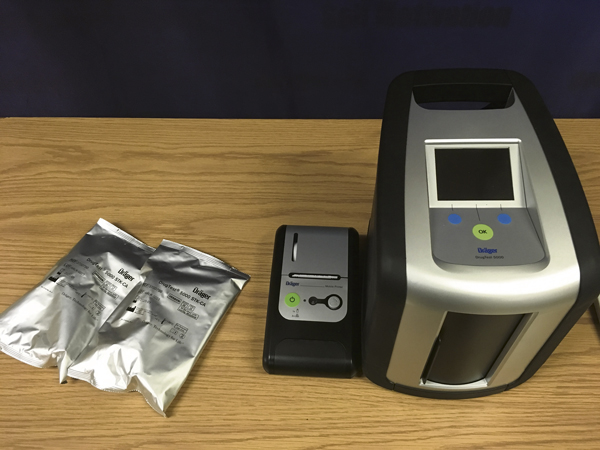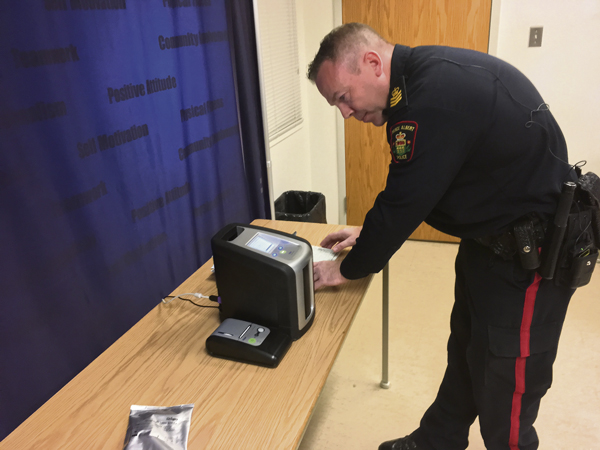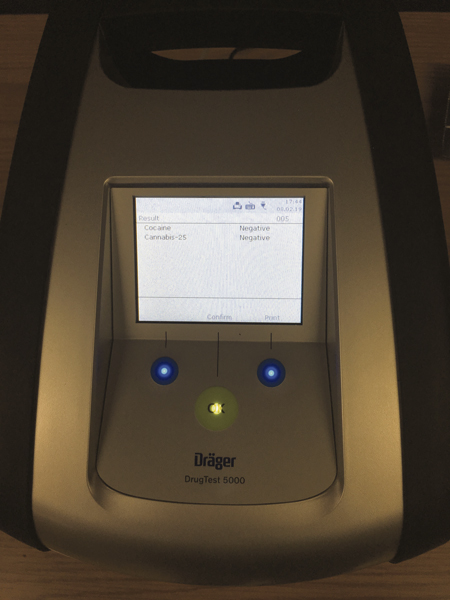
Police services across Saskatchewan now have a new tool to help catch impaired drivers.
The Prince Albert Police Service is among the forces to receive the new Dräger DrugTest 5000 machines, which use saliva samples to test for the presence of cocaine and cannabis. The machines are approved by the Government of Canada for use as roadside screening devices for drugs. Once an officer has a reasonable suspicion someone is impaired by cocaine or cannabis, they can use the Dräger as a way to get reasonable grounds to issue a demand for a drug recognition expert (DRE) test. A DRE is an officer specially trained to detect signs of impairment by different drugs. A DRE demand can also be made if a suspected impaired driver fails a Standard Field Sobriety Test (SFST)
“We use (the Dräger) as an investigative tool to detect drivers impaired by drugs,” Sgt. Terry Epp from the Combined Traffic Services Unit told reports Friday.
“This is a nice option to have, but we’re still going to rely heavily on our SFST people.”
Epp is one of only two Prince Albert officers trained on the use of the device.
The Dräger unit arrived about three weeks ago, but the service only received the certificate from the manufacturer that the device is calibrated properly a few days ago. They needed that certificate in order to put it into service.
“We haven’t used it in a real-life scenario as of yet in Prince Albert, but now we’re at the point where we can,” Epp said.
“It’s made to be a roadside screening device. It’s not meant to bring people to the police station and put them on it.”
The device got its first test subject Friday, when Ronald Quaroni, a reporter from PANow, volunteered to give the machine a go.
Epp removed a new mouthpiece from its packaging and showed it to Quaroni. The mouthpiece features a swab on one end and a blue indicator on the other. It’s attached to a larger, plastic casing that slots into the machine.
Epp handed Quaroni the mouthpiece and told him to move it around his mouth, catching the saliva pockets in his cheeks, under his tongue and in the front of his mouth. The mouthpiece generally takes about 30 to 45 seconds to collect enough saliva, but it can take longer if someone is on a drug that leads them to have a dry mouth.

After about 30 seconds, the other end of the swab, the indicator tip, had turned a light blue colour.
“That tells me there is a sufficient oral fluid sample on here,” he said.
“Then we can put it into the machine.”
Epp capped the sample and tucked it into a swab-shaped opening that had opened from behind a cover on the front of the device.
He pressed a few buttons, and the machine, no bigger than a small Keurig Coffee maker, began to hum.
“From this point on, the machine does the work,” Epp explained. “It’s going to take us 4-5 minutes to produce a result.”
While the machine works, Epp does too. The Dräger has a small keyboard attached to it, as well as a printer like the one you’d see at a cash register. That printer prints the ticket. While the machine is running its test, Epp can use the keyboard to enter information about the suspect — such as his age, name, height, weight and the circumstances of the traffic stop.
Once the machine finishes its testing, it prints out those details — plus an indication of whether the sample is positive or negative for cocaine and cannabis.
The machine beeped and Epp looked down. Cocaine: Negative. Cannabis: Negative. Even if the device were to detect the presence of drugs, it doesn’t say how much. That determination has to be made through further testing, including a possible blood test. The Dräger just gives officers the green light to continue their testing of an impaired driving suspect.
Epp said he and the other trained officer learned how to use the device while taking a course in Ottawa. But the operation, he said, is easy, and the machine walks him through most of the steps.

In addition to needing a trained officer to operate it, the Dräger is also very sensitive. It needs a flat surface to operate and doesn’t work well in cold weather. With all those limitations, Epp said it will be used as a secondary tool when they know they’re stopping lots of people, like at a check stop.
‘We’re trying to rely on our SFST because it’s not limited by bad weather or flat surfaces. We have ways around it,” he said.
“This is one additional tool we have in our arsenal to detect and take impaired drivers off of the road. We’ll definitely give it a shot in the right setting.”
Prince Albert isn’t the only department that will be giving the Dräger a try. A total of 16 will be used in Saskatchewan. Nine by the RCMP. The rest were sent to other municipal detachments.
Epp said the Prince Albert force is taking a wait and see approach to the tool’s effectiveness. It’s just that, he said, a tool, and it won’t replace officer training and investigation.
“Without good officer observation and investigation, we can’t even get to this point,” he said, gesturing at the machine, still beeping on the table.
“We can give it a shot, put it out there, see what kind of success we have and go from there.”

